October 10, 2008
Air Date: October 10, 2008
FULL SHOW
SEGMENTS
Nuclear Power Politics
/ Jeff YoungView the page for this story
The presidential candidates are going head-to-head on nuclear power. But the nuclear industry says Senators Barack Obama and John McCain aren't that far apart when it comes to a commitment to build more nuclear reactors. This week, Living on EarthÂ’s Jeff Young reports on John McCainÂ’s views on nuclear power. (07:00)
Raising Iraqi Oil
View the page for this story
Iraq is poised to become one of the largest oil producers in the world, introducing billions of barrels of oil onto the global energy scene. As a new law regulating its oil industry sits stalled in Parliament, Iraq's oil minister is starting talks with representatives of international oil companies. Living on Earth's host Bruce Gellerman talks with geopolitical analyst Peter Ziehan of the online magazine Stratfor about how and when Iraqi oil will surface. (5:00) (05:00)
View the page for this story
Google hopes to help wean the United States off oil and coal by 2030. In the process of eliminating our dependence on foreign oil, the company also plans to make a lot of money. Google's Director of the Climate Change and Energy Initiatives, Dan Reicher, explains their "do well by doing good" creed to host Bruce Gellerman. (05:30)
Endangered Mammals
View the page for this story
Twenty five percent of the worldÂ’s mammals are in danger of extinction. ThatÂ’s according to the Red List published by the International Union for Conservation of Nature. Mike Hoffmann, one of the authors of the study, speaks with host Bruce Gellerman about the list that brings together research from 1700 scientists on 5,500 species. (05:50)
The Hermit and the Marmot
/ Zachary BarrView the page for this story
For years, Billy Barr kept detailed records about plants, animals, and the weather, from his perch in a remote cabin in Gothic, Colorado. Scientists are especially interested in his logs about the rodent marmot, as Colorado Public Radio Zachary Barr reports. (06:30)
Arctic Methane
View the page for this story
The Siberian coast is largely uncharted territory, but an international team of scientists traveled the Russian waters in search of methane – a potent greenhouse gas – that is welling up from permafrost beneath the arctic waves. Host Bruce Gellerman speaks with head researcher Professor Orjan Gustafsson, of Stockholm University, about the team’s findings. (05:00)
Wild Coast
View the page for this story
Each spring along the southeastern tip of the African continent, a massive migration of sardines brings predators of all kinds together for a massive feeding frenzy. Steve McNicholas co-directed a three dimensional Imax film called “Wild Ocean” about the event. (08:00)
The Importance of Blackberries
View the page for this story
Technology can be friend or foe, depending on how we use it. Commentator Tom Montgomery-Fate wonders how much longer he can resist the pull of a PDA like the Blackberry, in his desire to stay closer to nature. (03:10)
This week's EarthEar selection
listen /
download
Show Credits and Funders
Show Transcript
Host: Bruce Gellerman
Guests: Mike Hoffmann, Steve McNicholas, Dan Reicher, Peter Zeihan
Reporters: Zachary Barr, Jeff Young
Commentator: Tom Montgomery-Fate
(THEME)
GELLERMAN: From Public Radio International, this is Living on Earth.
(THEME)
GELLERMAN: IÂ’m Bruce Gellerman.
The Presidential campaign goes nuclear to combat climate change – but skeptics say atoms aren’t the answer.
RICCIO: If you actually want to address climate change you need to do things that are fast and affordable. Last year we put five thousand megawatts of wind on the grid here in the United States. YouÂ’re not going to put that kind of nuclear power on the grid with a new reactor for well over another decade.
GELLERMAN: Also, a loner who spent years in a minerÂ’s shack in the Rockies left a mother lode of information for biologists.
BILLY BARR: Like here, March 21 1978: ‘I saw gray jay, grosbeak, raven, nuthatch, robin, and so on. It was really interesting - It was like 'oh look there's a nuthatch, I don't usually see a nuthatch in March, I'll make a note of it.'
GELLERMAN: And – The Red List. The most powerful mammal of all threatens many of the rest with extinction. These stories and more this week on Living on Earth. Stick around!
ANNOUNCER: Support for Living On Earth Comes from the National Science Foundation and Stonyfield Farm.
Nuclear Power Politics

Senator John McCain. (Courtesy of U.S. House of Representatives)
GELLERMAN: From the Jennifer and Ted Stanley studios in Somerville, Massachusetts, This is Living on Earth. IÂ’m Bruce Gellerman, in for Steve Curwood.
While the economic crisis is dominating the presidential campaign, energy and environmental issues are still getting significant play in the presidential debates. In their second debate in Nashville, Senators John McCain and Barack Obama went head-to-head on climate change.
MCCAIN: What's the best way of fixing it? Nuclear power. Senator Obama says that it has to be safe or disposable or something like that. Look, I've – I was on Navy ships that had nuclear power plants. Nuclear power is safe, and it's clean, and it creates hundreds of thousands of jobs.
OBAMA: And I've called for investments in solar, wind, geothermal. Contrary to what Senator McCain keeps on saying, I favor nuclear power as one component of our overall energy mix. But this is another example where I think it is important to look at the record.
GELLERMAN: Which is precisely what Living on EarthÂ’s Jeff Young is going to do. With a close look at where the presidential candidates stand on nuclear power. This week: John McCain.
YOUNG: After almost 30 years of near zero growth in the U.S., nuclear industry leaders say they are poised for a nuclear renaissance. And Senator John McCain is a nuclear renaissance man.
MCCAIN: IÂ’d like to say, IÂ’m very grateful to be here at the Fermi Nuclear Plant. I want to thank the great workers and people here who have made nuclear power safe, efficient, inexpensive and obviouslyÂ…
YOUNG: In August McCain toured the Enrico Fermi Nuclear Generating site in Michigan—a venue that struck some as an odd place to highlight nuclear safety. Nuclear opponent Jim Riccio of Greenpeace:
RICCIO: It’s one of the few sites in the U.S. where you’ve actually already had a meltdown. It was an experimental breeder reactor, and that reactor experienced a partial core melt back in ‘66. So it was ironic that of all the places in the U.S. that the senator could go he chose the site of a meltdown.
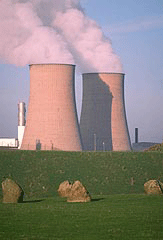
Cooling towers at a nuclear power plant (Courtesy of the Department of Energy)
FLINT: No, the Fermi plant operates very safely.
YOUNG: ThatÂ’s Alex Flint, the Nuclear InstituteÂ’s senior vice president for
government affairs.
FLINT: The entire nuclear renaissance is based on the fact that the 104 plants operating today have an extraordinary safety and environmental record. And it is that, itÂ’s the safety and environmental record of the existing plants that makes it possible for us to contemplate this renaissance in nuclear power.
YOUNG: But what happened at Fermi in 1966?
FLINT: Uh that was three years before I was born, IÂ’ll have to go off and ask somebody.
YOUNG: I think they had meltdown.
FLINT: No. no.
YOUNG: Flint called a colleague who confirmed FermiÂ’s meltdown history.
FLINT: (on phone) Okay, thatÂ’s what I needed. Thanks. (Hangs up) Well, you asked me a question I never heard before.
YOUNG: It was an awkward moment. And it reflects a larger awkward phase for the nuclear industry. The presidential campaign puts it in the limelight as a potential energy source for the future. But that also brings into focus nagging problems from the past—questions about safety, waste, and tremendous cost. McCain believes those challenges pale compared to the threat of global warming.
MCCAIN: And, you can't be serious, you can't be serious about reducing the effect of greenhouse gas emissions unless you factor in nuclear power into the equation.
YOUNG: That was McCain in an interview with Living on Earth in 2004. The following year he added incentives for nuclear power to his Climate Stewardship Act, which aimed to cut greenhouse gas emissions. That alienated some environmental allies and cost crucial votes in the Senate, where the Act failed.

Senator John McCain. (Courtesy of U.S. House of Representatives)
Now McCain proposes 45 new reactors by the year 2030—and a longer-term goal of 100 reactors. Again, environmentalists like Jim Riccio, who applauded McCain for tackling global warming, are aghast at his insistence on nuclear power.
RICCIO: If you actually want to address climate change you need to do things that are fast and affordable. Last year we put 5,000 megawatts of wind on the grid here in the United States. YouÂ’re not going to put that kind of nuclear power on the grid for well over a decade and by then climate change will be upon us, and potentially unabateable.
YOUNG: The Nuclear Institute says 45 reactors would keep nuclear at 20 percent of the countryÂ’s electricity mix as demand rises. But some who watch energy investments arenÂ’t so sure the money to build them would be there. Kevin Book is an energy analyst with FBR, an investment bank in Arlington, Virginia.
BOOK: It will be a stretch, to be quite frank. The problem will be getting them built, and getting them built with the labor force we have, and at prices that local regulated utilities will want to pay. YouÂ’re still going to need a lot of money and youÂ’re going to need a lot of time. ItÂ’s 2008, last time I checked. That gives 22 years to build 45 of something we havenÂ’t built in 30 years. From my perspective that sounds like a challenge.
YOUNG: Book says pinning down the cost is tricky—estimates for a new reactor vary from four to nearly 11 billion dollars. At, say, seven billion each, McCain’s proposal means 315 billion dollars someone has to come up with. And that someone could be you, as a ratepayer or taxpayer. The industry would get billions in production tax credits. And taxpayers could be on the hook for much greater sums if companies default on government-guaranteed loans. And then there is the question of what to do with the waste. McCain wants to finish the Yucca Mountain repository for permanent underground storage. But that project faces opposition in congress and the courts. McCain also wants the U.S. to reprocess the spent fuel.
MCCAIN: The Japanese, the British, the French do it, and we can do it too.
YOUNG: Reprocessing—sometimes called recycling—separates useful material from spent fuel. But it’s controversial among nuclear experts. MIT professor and former Clinton administration energy department official Ernie Moniz says it’s a bad idea.
MONIZ: There is a misconception that the program in France, for example, that relies upon plutonium recycling, has somehow solved the waste management problem. It has not. It costs more, it creates stores of plutonium. So there are some issues there that need to be clarified.
YOUNG: So both of McCainÂ’s plans for dealing with waste would run into opposition. Financing construction of new reactors would be very tough. And safety concerns from environmentalists would complicate McCainÂ’s effort to link nuclear power incentives to climate change legislation. But for all the criticism McCain catches, he has at least been consistent. Which has not been the case with his opponent.
OBAMA: I am not a nuclear energy proponent.
YOUNG: This was Senator Obama last year. HereÂ’s Obama this month.
OBAMA: I favor nuclear power as one component of our overall energy mix.
YOUNG: Just where does the Democratic presidential candidate stand? WeÂ’ll take a look at his nuclear record next week.
For Living on Earth, IÂ’m Jeff Young in Washington.
Related links:
-
- Nuclear Energy Institute on outlook for new reactors
- Greenpeace on the nuclear-climate connection
- For more LOE election coverage, click here
Raising Iraqi Oil
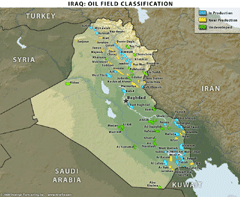
Warning: mb_convert_encoding() [function.mb-convert-encoding]: Illegal character encoding specified in /home/phoenixsoap/loe.org/docs/staff/content/showtool.html on line 104
IraqÂ’s oil fields: undeveloped (in green), in production (in blue), and near production (in yellow). (Courtesy of Stratfor)
GELLERMAN: Iraq has a lot of oil. A LOT of oil. Right now it’s sitting on 115 billion barrels of oil. And some estimates suggest there are three times that waiting to be discovered, which would give Iraq a quarter of the world’s petroleum reserves—more than Iran, even more than Saudi Arabia. That’s what’s at stake this week as international oil companies meet with Iraqi officials in London to talk contracts.
Joining me to talk petropolitics is Peter Zeihan, director of global analysis for Stratfor, an online publisher of geopolitical intelligence. Peter, welcome to Living on Earth.
ZEIHAN: Thank you very much.
GELLERMAN: Let’s talk Iraqi oil. Iraq wants to boost its oil production from what – the current 2.2, 2.4 million barrels a day to about 4.5 million barrels a day. Can it do it, and, if so, how?
ZEIHAN: Iraq clearly has the infrastructure in place to take it to that level and probably considerably beyond without even tapping any of their unknown areas in the Western Desert and the far north. Most of the major export routes are broadly functional. Those that had been disrupted by terror attacks or the bombing campaign back in 2003 are all things that could be repaired. And even if you have to rebuild the entire thing from scratch, the vast majority of the crude is in the south, and the south is very, very close to the Persian Gulf. So youÂ’re really talking about low investment costs to get up to that level, and thatÂ’s without going into the more prospective stuff in the Western Desert.

Stratfor analyst Peter Zeihan.
GELLERMAN: Okay. So whatÂ’s standing in the way of getting Iraqi oil online?
ZEIHAN: Well, to be perfectly blunt, IraqÂ’s not a real country yet. YouÂ’ve got three different sectorial groups, the Kurds in the North, the Shia in the South and the Sunnis in the center who donÂ’t agree on much. And one of the things you have to agree on is how youÂ’re going to split the revenues. To do that you have to have a petroleum law of some sort. Until that is into place, itÂ’s pretty much illegal for any foreigner to come in and do any major work.
GELLERMAN: Well the current Iraqi oil minister, Hussein al-Shahristani is gonna be in London this week to meet with representatives of the international oil companies. What do you think is going to come out of that?
ZEIHAN: Very little. Shahristani and his predecessors had many talks like this. All of them have come away with smiles and handshakes and pledges to do more cooperation and investment deals, but until you have an oil law, really all you can do is surface contracts and thatÂ’s not something that most major oil companies are interested in. They want to think in hard money, they want to work on hard projects, they want to get access to hard oil, and we canÂ’t do that until we have an oil law.
GELLERMAN: So this meeting in London—do you think it’s a way around not having a hydrocarbon law?
ZEIHAN: ItÂ’s an attempt, certainly. The oil ministry wants to make sure that as soon as an oil law is adopted, that everybody can hit the ground running. And that means maintaining as good of contacts with the oil companies as possible. One big concern I have, is that when you do have meetings like this that are technically happening extra-legally, the opportunities for corruption are insanely huge, because thereÂ’s no format for any sort of recording of the proceeds. ItÂ’s very easy for this to slip into a lot of palm greasing. In fact, the Iraqis will probably insist upon it, saying that if you want a leg up when this law finally does come through, you need to make good on that now in some small way.

IraqÂ’s oil fields: undeveloped (in green), in production (in blue), and near production (in yellow). (Courtesy of Stratfor)
GELLERMAN: Could Iraq develop its oil fields without the help of international oil companies?
ZEIHAN: To a limited degree, yes. The oil services firms, in particular, have been very active in Iraq and are only getting more so. But ultimately you’re going to have to bring in a lot of fresh investment for fields that haven’t really been tapped yet. Now the Iraqis, unlike most national oil companies, whether they be in Nigeria or Iran or Venezuela, are actually technically competent. Remember they kept the system going despite fifteen years of wars and sanctions—that is no small achievement. But there is only so much you can do until the security situation settles down.
GELLERMAN: Iraq has an awful lot of proven reserves—what, about a 115 billion barrels. I was reading it could have 200 billion barrels. It could have 300 billion barrels, which would give it more than Saudi Arabia.
ZEIHAN: ItÂ’s entirely possible. A lot of the major deposits in Saudi Arabia are built on geological formations that extend deep into Iraq, same with Iran. Iraq could be the worldÂ’s largest producer in ten, fifteen years. Because the topography is very simple, because the oil fields are very large and very shallow, this is going to be the part of the world with the lowest lifting costs. The money, if itÂ’s going to go anywhere into oil production, itÂ’s going to go here. You can look forward to Iraq producing an additional million barrels per day, and that would easily make Iraq the largest oil producer in the world.
GELLERMAN: Well, Mr. Zeihan, thank you very much. Appreciate it.
ZEIHAN: Not a problem.
GELLERMAN: Peter Zeihan is director of global analysis for Stratfor.
For a different take on IraqÂ’s oil future, you can find a conversation with Saddam HusseinÂ’s oil minister on our Web site, loe.org.
Related link:
Stratfor
[MUSIC]
GELLERMAN: Just ahead, Googling climate change. Keep listening to Living on Earth!

Google has teamed up with General Electric to build a smart grid for plug in electric cars. (George W. Hatcher)
GELLERMAN: ItÂ’s Living on Earth, IÂ’m Bruce Gellerman.
Google, the online search engine, has always had lofty ambitions. Founded a decade ago, the company name was derived from the mathematical term googol, g-o-o-g-o-l, or ten to the 100th power. ThatÂ’s a number larger than all the elementary particles in the universe. Well, now the Web search company is again reaching for the stars. Google says the U.S. can be coal- and oil-free by 2030, and itÂ’s putting 45 million dollars where its mouth is. Dan Reicher is GoogleÂ’s Director of Climate Change and Energy Initiatives.
REICHER: Well, you know, at Google we really have brought together the opportunity to both do well and do good here. We really do believe that we and others can make money at this—really moving clean energy technology into the commercial sector. We’ll also be solving many of these energy and climate problems we have.
GELLERMAN: Okay, well, how do we do it?
REICHER: First, weÂ’ve got to keep the demand for electricity flat, instead of it growing twenty or twenty-five percent over the next twenty plus years. Secondly, we do need to replace coal-generated electricity with clean electricity from renewables. And third, we strongly feel weÂ’ve gotta increase the use of plug-in vehicles. Major car companies from Toyota to General Motors to others are actually coming out with plug-in vehicles. What we want to do at Google is make sure in fact, that the grid is ready for that.
GELLERMAN: What do you think is the toughest nut to crack?
REICHER: Well one of the really difficult challenges we have as a country is that as much as there’s excitement about renewable electricity—solar, wind, geothermal and the like—one of the big challenges we have is moving that electricity from where the sun shines or the wind blows to where people actually live. We do not have adequate power lines to move wind electricity from the Dakotas to Chicago or from the desert Southwest to Los Angeles or Las Vegas. And as a country we’ve gotta figure out a way to build more power lines if we’re really gonna take advantage of these clean, renewable sources of electricity.
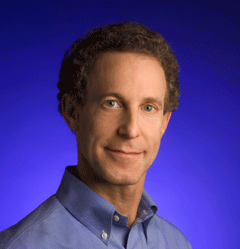
Dan Reicher is Director of Climate Change and Energy Initiatives at Google.
(Courtesy of Google)
REICHER: Well, that’s a great example. You know the REA, the Rural Electrification Administration, in fact, brought power lines to people in rural areas. We built the interstate highway system and created lots of jobs and spurred our economy. We think rebuilding our electricity system—taking it from one that really dates from the ‘50s and ‘60s to one that really is twenty-first century has a lot of the same opportunities—a lot of job creation and at the same time, really being able to take advantage of these clean energy sources.
GELLERMAN: As a company, your primary function is to provide users with a search engine for accessing information on the Internet. Tens of millions, hundreds of millions of Americans use you. Are there plans to somehow tap into the online resources to further the 2030 goal?
REICHER: Absolutely. We think thereÂ’s all sorts of ways that we can both get information to people and also give them the ability to control their energy use, to monitor their energy use day to day. ItÂ’s a very primitive situation today where all you hear from your utility is this once-a-month paper electricity and gas bill. It gives you very little sense about what you can actually do to control that energy use. The ability to go online, interact with people, help them control their appliances and equipment in their own homes, better assess what their cars are doing at any given moment -- We think thereÂ’s big big opportunities there for Google and lots of other information technology companies.

Google has teamed up with General Electric to build a smart grid for plug in
electric cars. (George W. Hatcher)
GELLERMAN: So IÂ’d be able to go online and maybe lower the thermostat in my house, or maybe check my electric bill hour by hour, minute by minute?
REICHER: There’s all sorts of work going on by a number of companies to give you that ability and we’re very interested in that at Google, and think it’s got big promise—and stay tuned.
GELLERMAN: Boy, Google – first the Internet, now the world.
REICHER: Well, it’s exciting. And I did want to point out another very interesting technology—it’s called Enhanced Geothermal Systems or EGS. Traditional geothermal is where you drill a well down to a pocket of steam or hot water and you bring that up and make electricity. Well, it turns out if you drill literally anywhere on the earth, if you drill deep enough, you get to hot rock. If you can open up the crevices down there, fracture the rock, and put water down and bring it back up, you can make electricity in much, much greater quantities. So we’ve made a series of investments at Google in companies focused on this. And we’ve also gotten the word out to people all over the country and all over the world. You can see a Google Earth layer that shows the EGS resources in every one of the fifty states in the United States. We’re trying to use our information tools and our capital to really advance this very promising technology.
GELLERMAN: Boy, I can already hear the slogan: Drill, Google, Drill!
[LAUGH]
REICHER: Well our CEO did a speech a week ago and the title of it was “Where would Google drill?” You know, I’m really typically optimistic about what we can do as a country. If we can catch up at the national level with a strong push from Washington, I think we can make a good down payment on cutting greenhouse gas emissions and cutting our foreign oil dependence and frankly making some money in the process.
GELLERMAN: Well Dan Reicher, I want to thank you very much. A pleasure talking with you.
REICHER: Great talking with you, Bruce
GELLERMAN: Dan Reicher is Director of Climate Change and Energy Initiatives at Google.
Related link:
The Google 2030 challenge
Endangered Mammals
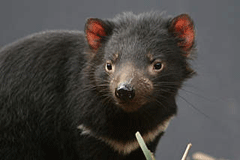
Tasmanian devil. Threat category: endangered. (Photo: David Hewett)
GELLERMAN: Mammals are warm-blooded animals that have backbones and hair. They produce milk and most give birth to live young. Mammals range from the thumb-sized bumblebee bat to the enormous Blue Whale whose heart alone is as big as a compact car. There are about 5500 known species of mammals, but a new report says many face extinction. The report—the Red List—is the work of 1700 researchers from around the world. The findings were released in Barcelona, and joining me from there is Mike Hoffman. He’s a biologist with the International Union for Conservation of Nature and Conservation International and he’s co-author of a summary of the study appearing in the latest edition of Science.
Hello, Mike Hoffman
HOFFMANN: Hi, how are you doing?
GELLERMAN: I’m well but—boy, but reading this report, the 2008 Red List, mammals aren’t doing well.
HOFFMANN: No, mammals are definitely not doing well. As you pointed out, one in four of every mammal species threatened with extinction. And some groups, like the primates, are very, very threatened. One in two species are threatened with extinction—now that is just phenomenal. And, of course, the big, big issues here that are having a real impact: hunting and habitat loss.
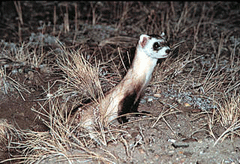
Black footed ferret. Threat category: endangered. (Photo: Dean E. Biggins)
GELLERMAN: Well it seems that the primates at the top of the food chain—us—we’re doing pretty well.
HOFFMANN: We’re doing pretty well. In fact, actually, it’s worth mentioning that this is the first time that humans have actually been assessed for the IUCN Red List. And, needless to say, given how widespread and abundant we are, and that our populations are increasing, it comes as no surprise that we’ve listed ourselves as “least concern.”
GELLERMAN: Well have we met the enemy, and it is us when it comes to the other mammals? Are we the cause of this?
HOFFMANN: So yeah, primarily what we’re seeing is the impact of human disturbances on our environment. When I say that habitat loss is the biggest threat to mammals worldwide, well, in fact, it’s not just to mammals, it’s generally to biodiversity. When it’s combined with the impact of hunting—and hunting takes place for food, it takes place for the use of species for traditional medicine—that really results in these massive declines taking place. So if you go into parts of the world like Southeast Asia, you know, in the case of primates which I just mentioned, 80 percent of the species are threatened with extinction. Now that is just a staggering fact when you stop to think about it – 80 percent of primates threatened with extinction. These are large-bodied species, they take a long time to mature, and, of course, they’re easy to hunt. And the other thing that I think is interesting is that we are seeing some of these interesting emerging threats. I don’t think we really have a handle yet on what the impacts of climate change are really going to be, but at least for species like polar bears and harp seals which are dependent on sea ice, there’s no doubt that climate change is having a dramatic effect—or will have a dramatic effect on their populations in the future.
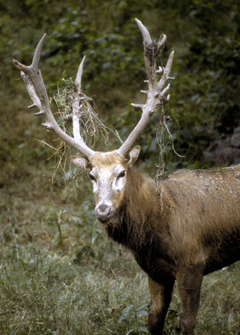
Pere David's Deer. Threat category: extinct in the wild. (Photo: Jessie Cohen)
GELLERMAN: You know Mike, there have been five mass extinctions throughout history. Are we headed for a sixth?
HOFFMANN: I think so. Let me firstly be clear—extinction is a natural process, you know. Species do go extinct. You know, we as biologists cannot deny that. What is not natural is the rate at which extinctions are taking place today. And scientists when they actually measure the rate of extinction taking place today, they talk about extinction rates on the order of a hundred to a thousand times greater than the normal rate of extinction. Now that is, that is scary.
GELLERMAN: I noticed that the Tasmanian devils, the population has dropped by 60 percent in the last ten years. And I’m just wondering—well, I don’t want this to sound too ugly, but—why would I care about Tasmanian devils?

Tasmanian devil. Threat category: endangered. (Photo: David Hewett)
HOFFMANN: Yes, I, you know, I think it’s a good question. I think there are two reasons. Firstly there’s the argument I like the most, which is simply that I think we have a moral obligation to care. However, I also do want to clarify that there are practical reasons for why we need to conserve these species. And that is simply that, you know, when you take one of these animals out of an intact ecosystem, you just can never tell what the impacts are going to be on that population. If you take predators, you know, top-ranking predators out of an area, the result of course is an explosion in your prey base. And the result of that, of course, can be very, very detrimental to native vegetation. And species like primates and so forth are extremely important because they are seed dispersers—you know, they feed on seeds and they distribute them through the forests and they help in tropical forest regeneration. If we lose these species, the impacts on tropical forest habitats are going to be tremendous.
GELLERMAN: Have we reached the tipping point, have we gone too far, is there anything we can do to prevent this?
HOFFMANN: Oh, definitely. I – you know – so one of the things I’m very optimistic about is that the Red List is all—I mean the primary purpose of the IUCN Red List is to flag species at risk of extinction in the wild, and I think that it does that very, very well. And partly as a result of that, we’ve seen some tremendous recoveries in species that were once really on the brink, now being pulled back. And, you know, I think what this tells us is that conservation action, when it is targeted, when it’s strategic and when we have the resources and we, you know, we make an effort to actual invest them wisely—we can be successful. In North America, we have the black-footed ferret, you know, this was a species extinct in the wild. And now, as a result of captive breeding and reintroduction programs and looking at how to stop the threats in the wild this species has been recovered and it’s now been down listed to “endangered.” So what the message is, is conservation does work—we just need more of it.
GELLERMAN: Well Mike Hoffmann, I want to thank you very much.
HOFFMANN: Thank you very much. It was fun being on the show.
GELLERMAN: Speaking to us from Barcelona, Spain is biologist Mike Hoffmann. HeÂ’s co-author of a summary of the Red List, that appears in the latest edition of Science. You can find a link to the Red List at our Web site, loe.org.
Related links:
- This link takes you to the online version of the red list
- International Union for Conservation of Nature
The Hermit and the Marmot
GELLERMAN: Well it’s quite a ways from Barcelona—to the ghost town of Gothic, Colorado—but both provide us with important data about the disrupting effects of global climate change on nature. Key to our understanding are historical records. Which is why research scientists owe a debt of gratitude to a loner named Billy Barr—who kept meticulous notes about the weather and animals in remote Gothic, Colorado.
Reporter Zachary Barr—no relations to Billy—has our story.
ZACHARY BARR: When Billy Barr first came to Colorado, he was an East Coast college student looking for, in his words, ‘a quiet space to get away from social pressures.’ So when he got to the ghost town of Gothic, high up in the Colorado Rockies, he knew he wanted to stay a while. He began the winter of 1974 in a tent. At this altitude it snows twenty-five feet a year. Halfway through that first winter, the owner of an old mining shack saw how Billy has living and offered the shivering camper his abandoned cabin.
BILLY BARR: This is where the cabin used to be. It ran from here, eight feet this way and ten feet that way.
ZACHARY BARR: ThatÂ’s Billy. That shack burned down several years ago, and so right now heÂ’s tracing its perimeter on the ground with a stick.
BILLY BARR: Just this little square here and that was it. And I spent eight years in that.
ZACHARY BARR: In an eight-by-ten cabin?
BILLY BARR: Yeah.
ZACHARY BARR: Inside the tiny shack, winters were long and frigid. Blowing snow was everywhere, including inside the cabin. On top of that, Billy could go weeks without seeing another human. So itÂ’s not surprising that he paid special attention to animals.
BILLY BARR: Like hereÂ’s March 21, 1978. I saw a grey jay, a grosbeak, a raven, a nuthatch and so on.
ZACHARY BARR: Billy kept incredibly detailed notebooks, jotting down every animal he saw, every day, all winter long. Then, when spring was near, new animals showed up.
BILLY BARR: Yeah, it was just interesting. It was like, oh look, thereÂ’s a nuthatch. I donÂ’t usually see a nuthatch in March. IÂ’ll make note of it.
ZACHAY BARR: WhyÂ’d you do this?
BILLY BARR: You know, I was living in an eight-by-ten-foot shack with not a lot to do.
ZACHARY BARR: Now thatÂ’s the backstory. But you also need to know that BillyÂ’s shack is near the Rocky Mountain Biological Lab. ItÂ’s a summer research station where Billy now works as the office manager. In addition to other things, the lab is a sort of worldwide headquarters for people researching marmots. In case you didnÂ’t know, Italian grad student Eleanora Ferrando explains.
FERRANDO: Oh a marmot is like a big rodent. TheyÂ’re not like big rats. TheyÂ’re nice, and theyÂ’re really cute.
[SOUND OF WALK]
ZACHARY BARR: Today Eleanora is helping to tag marmot pups Â….
[CHIRPING OF MARMOT PUPS]
ZACHARY BARR: Â… who chirp this alarm call when theyÂ’re temporarily caught inside a live trap.
[CHIRPING]
ZACHARY BARR: But despite studying the furry brown creatures for decades, researchers didnÂ’t know when marmots wake up each spring from hibernation. And thatÂ’s something biologist David Inouye was interested in. And he, like Billy, spends a lot of time at the field station. Do you see where this is going? About eight years ago David found out about BillyÂ’s notebooks. Eureka!
INOUYE: Billy has data for chipmunks, he has data for ground squirrels, he has data for marmots. I think thatÂ’s why itÂ’s unusual, the fact that there is this record for, a long term record for, a small mammal emerging from hibernation. ItÂ’s not something that many people have paid attention to in the past.
ZACHARY BARR: David took BillyÂ’s observation and compared it to temperature records. Over the past thirty years, average spring temperatures in Gothic have risen two degrees Fahrenheit. And over that same period of time, marmots are emerging from hibernation about three to four weeks earlier.
INOUYE: Used to be when marmots would come up through the snow in April they’d stick their heads out, it was still cold and they’re go back down and hibernate for a few more weeks. But now when they come out through the snow, it’s relatively warm. They decide, ‘oh, winter’s over’ even though they may have had to dig themselves out of six feet of snow.
ZACHARY BARR: And thatÂ’s what happened this year. Snow was everywhere, and so coyotes had a field day eating marmots. ThereÂ’s just nowhere to hide. Scientists arenÂ’t concerned about marmots going extinct, but some species are threatened, particularly those that live only at high elevations. And some animals, like these, are being forced to higher ground.
INOUYE: ThereÂ’s at least one species of bumblebee that seems to occur about 2,000 feet higher in altitude now than it used to back in the 1970s, and others that seem to be disappearing, or at least becoming very rare, at lower altitudes.
ZACHARY BARR: Now, everything we’ve been talking about has a scientific name – phenology. That’s the timing of the life cycle events of plants and animals, when flowers bloom, when birds migrate, or when marmots stop hibernating. And all over the world, there’s increasing evidence that climate change is messing up phenology in nature. But if you’re a scientist, you need hard data, so the push is on to find more people like Billy Barr.
WELTZIN: Anybody can learn how to do the monitoring of a plant in their backyard. And they can enter their data online. Then it becomes part of the national database to understand how climate change is affecting those plants across the United States.
ZACHARY BARR: ThatÂ’s Jake Weltzin. HeÂ’s heading up the National Phenology Network. ItÂ’s just launched a Web site where you can submit your own data. So far, one of the networkÂ’s most impressive finds comes from Tuscon, Arizona.
WELTZIN: We were contacted by a citizen scientist named Dave Bertelson. And Dave, it turns out, had been hiking up the Catalina Mountains on a five-mile trail for twenty years. Each Wednesday, he would track the plants that he saw that were in flower, and he would record that information.
ZACHARY BARR: DaveÂ’s notebook had 110,000 observations. But even if you have zero observations, you can start now, just by keeping an eye on whatever nature is in your daily life.
WELTZIN: If you live in the Northeast, you can help us monitor sugar maple. If you live in Tuscon, help us monitor Saguaro. For some species like dandelions, that grow everywhere, we encourage people to actually help collect data on those.
ZACHARY BARR: And if that sounds interesting, thereÂ’s one more volunteer job you should know about. TheyÂ’re going to need someone new in Gothic, Colorado soon. Billy BarrÂ’s moving. HeÂ’s built a house an hour away and 2,000 feet lower down in Gunnison. He says he just canÂ’t stand the winters anymore.
For Living on Earth, IÂ’m Zachary Barr.
GELLERMAN: Coming up, methane from under the Arctic Sea—and the choreography of the food chain along South Africa’s wild coast. Our voyage continues. It’s Living on Earth.
ANNOUNCER: Support for the Environmental Health Desk at Living on Earth comes from the Cedar Tree Foundation. Support also comes from the Richard and Rhoda Goldman fund for coverage of population and the environment. And from Gilman Ordway for coverage of conservation and environmental change. This is Living on Earth on PRI, Public Radio International.
Arctic Methane

The ship Yakov Smirnitskii. (Photo: Martin Krus, Stockholm University)
GELLERMAN: It's Living on Earth. I'm Bruce Gellerman.
Russian and Swedish scientists have found places in the Arctic Sea where huge amounts of methane are venting up from the ocean basin. Methane is a powerful greenhouse gas, and the unexpected discovery is causing concern among some scientists who fear it might speed up global warming. Professor Orjan Gustafsson at Stockholm University recently returned from an expedition which found the methane, and he joins me by phone from Stockholm. Welcome Professor!
GUSTAFSSON: Thank you.
GELLERMAN: WhereÂ’s the methane coming from?
GUSTAFSSON: Methane in the water on the East Siberian Artic Shelf is coming from sub-sea permafrost. This sea bottom used to be on land in the last ice age, and then was basically peat, that was frozen, permafrosted. And then the deglaciation—when it got warmer, the climate, then the sea levels was rising and the frozen peat was flooded. And it holds a large amount of methane. The conventional thought has been that this has been capped by the permafrost and held in place, but high levels of methane is now found in the seawater.
GELLERMAN: What would be causing this?
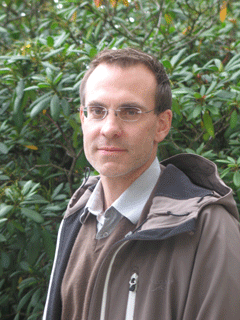
Örjan Gustafsson. (Photo: Linda Carlsson, Stockholm University)
GUSTAFSSON: There are three different mechanisms whereby this permafrost could be thawing. First one is geothermal heat flux. Basically, cracks in the Earth’s crust where heat from Earth’s interior is pushing up and thawing the permafrost. Another mechanism is basically when the sea level’s rising and sea water’s flooding over this land, then the sea water itself which might hold plus two degrees Celsius or so at sea bottom is providing heat to slowly thaw the permafrost. And final key mechanism is likely because of plumes of the very large Russian artic rivers that is pushing out warmer river water on the shelf—is also providing heat to thaw the permafrost.
GELLERMAN: How big is this area that this is happening?
GUSTAFSSON: The East Siberian Artic Shelf is the worldÂ’s largest continental shelf, and it covers about 50 percent of the total Artic Ocean. We donÂ’t know exactly how much methane is actually being released. What we found during the expedition is that in five or six regions, each of the area of tens of thousands of square kilometers, methane concentrations in sea water was found to be about a hundred times higher than the background methane levels in sea water. We just came back ten days ago from the expedition, and we now need to look at the full data set to evaluate what the total methane in the water column is and how quickly that might be fluxing out to the atmosphere.
GELLERMAN: Can you see the bubbles coming up out of the water?
GUSTAFSSON: You cannot see them by naked eye. I tried actually. I stepped out on the deck to try to see if I could see them by naked eye—these bubbles. I could not. But you can see them with our geophysical instrumentation.
GELLERMAN: What do we make of your findings so far?

The ship Yakov Smirnitskii. (Photo: Martin Kruså, Stockholm University)
GELLERMAN: Well itÂ’s winter up there now. Are you going back to sea?
GUSTAFSSON: No, not personally. Fifty days at sea in August and September is sufficient in the Artic. And now it’s freezing over very rapidly. However, our Russian colleagues, they are having some plans to return this winter as they were there also last winter having an expedition on the ice—going with large tractors on the ice and then pulling a caravan on the locked-up sea and then drilling holes in the ice and doing winter time sampling.
GELLERMAN: Well Professor Gustafsson, thank you very much. I appreciate your time.
GUSTAFSSON: All right, thank you very much.
GELLERMAN: Professor Orjan Gustafsson from Stockholm University. HeÂ’s co-chief scientist of the International Siberian Shelf Study expedition. He spoke to us from his home in Stockholm, Sweden.
Related link:
Siberian Shelf Study
Wild Coast
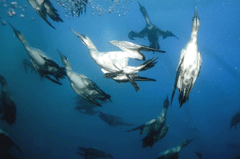
A close up of Gannets as they find a meal off Wild Coast. (Courtesy of Wild Ocean, Photo: Luke Cresswell)
GELLERMAN: And now for some armchair adventure. Showing in IMAX theaters around the nation, is a new 3-D movie: Wild Ocean.
MOVIE VOICEOVER: There is a place where man still shares the ocean, where the food chain is still unbroken. This is where Africa meets the sea.
[MUSIC FROM FILM]
GELLERMAN: The KwaZulu-Natal Coastline—stretching from the east coast of South Africa to Mozambique, is the scene of an annual migration spectacle. Billions of sardines, driven towards the coast by warm ocean currents swarm in the sea, as sharks, seabirds, and dolphins wait.
“Wild Ocean” was co-directed by Steve McNicholas. You might know the English dancer-choreographer for his percussion theater troupe, Stomp. McNicholas traveled to South Africa to film another kind of choreography—and epic epic struggle for survival.
MCNICHOLAS: I was stunned. It was 2005, July, 2005, which is winter down there. And I was in a helicopter. We were scouting along the coast, so just taking photographs of the coast. And then I just saw this huge—it looked like—it honestly looked like an oil slick. I really thought there’d been some kind of spillage, because I’d actually just passed—there was a wreck of a tanker along the coast. But it was fish. It was this huge shoal of sardines that was really just a fraction of the shoal that was traveling along that coastline that was just swept into a little beach area. And they were literally coming up on to the sand on the beach. We landed the helicopter and went down and looked, and just this whole frenzy of people taking the sardines out of the water. The women going in with skirts and scooping sardines out in their skirts, people running in with buckets, taking fish out with buckets. And while all this is happening, you had—there was probably about twenty sharks moving in from the deeper water. So these sardines were truly doomed because on one hand you got the people on the beach who are going for them, you’ve got sharks in the water going for them and you’ve got gannets were coming in from above.

Men offloading sardines at Mossel Bay, Eastern Cape. (Courtesy of Wild Ocean, Photo: Steve McNicholas)
GELLERMAN: I gotta tell you, those gannets, those birds, they look like they’re dive bombing, they’re kind of dropping out the sky, going boom—head-first right into the water.
[MUSIC]
MCNICHOLAS: Oh, they’re incredible. I mean they plummet from 30, 40 foot in the air straight down into the ocean. And as you watch them, it’s almost like they dislocate their wings or they become a living dart so when they hit the water—their skulls are specially strengthened to be able to take that impact, so when they hit the water, they go as deep as they possibly can with the—you know, the force of gravity takes them.
GELLERMAN: How did you film that because youÂ’ve got them falling out of the sky and then you see them in the water as they hit, under water. Is it one camera or two?
MCNICHOLAS: We had multiple cameras on his project. Above water we used IMAX cameras, as much as we possibly could we shot with 3D IMAX camera. And the aerial shots are shot with 2D. So weÂ’re with the gannets in the helicopter above with an IMAX camera on the helicopter. WeÂ’ve got a boat with a 3D IMAX camera taking the gannets as they hit the water. And then under the water we were shooting in high definition, and again in 3D. It can get pretty hairy. ItÂ’s difficult, but the reason we wanted to shoot in 3D is because we knew the action with the sharks and the dolphins and the gannets, we knew in 3D that was going to be stunning.
GELLERMAN: The dolphins at one point are feasting on the sardines and it looks like the sea is boiling.
[DOLPHIN SOUNDS AND MUSIC]
GELLERMAN: And the music is matching this frenzy.
MOVIE VOICEOVER: The sea is alive with predators, unconcerned with each other, focused only upon taking the sardines from every conceivable direction. An undersea battle has begun.

A close up of Gannets as they find a meal off Wild Coast. (Courtesy of Wild Ocean, Photo: Luke Cresswell)
[MUSIC CONTINUES]
MCNICHOLAS: Well thatÂ’s the thing. We are divers who are first and foremost musicians so when weÂ’re working on the music what we want to do is create a score that made you, well, helped you to feel the emotions that you feel when youÂ’re actually there. Because it is a massive adrenaline rush to be, you know, surrounded by sharks and dolphins and this frenzy. Massive adrenaline rush.
[MUSIC CONTINUES]
GELLERMAN: DÂ’you ever feel afraid?
MCNICHOLAS: Yeah. It’s—you don’t belong there. You’re in someone else’s territory. And, for me, the one moment when I really felt nervous was actually in the helicopter and we were above a shark feeding frenzy and looking down into the water, and I just suddenly thought, if we were to ditch the helicopter now, there’s no escape. Those sharks were going absolutely crazy. And there was, maybe about sixty sharks, and all going absolutely crazy below me. And I also knew from stories along that coastline that when ever anyone does ditch, or if there’s a wreck there are generally—no bodies are usually found.
GELLERMAN: I guess you have the highest concentration of shark species there. YouÂ’ve got these dolphins, youÂ’ve got the people coming in from the land. This ecosystem is, really, extraordinary. And it all happens at this one time of year.
MCNICHOLAS: Yes. Well it all happens because of the cold water that is kind of thrusting northwards from the southern cape is kind of hemmed in to the coastline area from the warmer water coming in from the north. So what happens is that these fish get kind of forced in to these shallow waters very prematurely for them, because they wouldnÂ’t normally go into shallow water. And thatÂ’s why theyÂ’re kind of trapped. And thatÂ’s why so many predators are attracted to it. The thing that struck me though, is the more I read about it and the more I learned about it, I realized that what weÂ’re calling extraordinary, what weÂ’re calling a one-off event in the natural calendar, it used to happen on a much bigger scale than we witnessed in South Africa. It used to happen off both east and west coast America and basically we ate them all. We overfished.
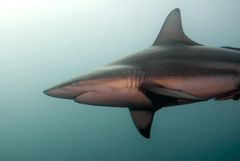
A black tip shark passes by the camera. (Courtesy of Wild Ocean, Photo: Luke Cresswell)
GELLERMAN: At one point in your film the narrator asks, you know, what can we do to keep the oceans alive. You never answer that question in the film. Did you not want to be preachy?
MCNICHOLAS: I see what you mean. No, didn’t want to be preachy. You know that’s just not the way I’d like to go about it. I don’t preach in my personal life. You know, I really think that if people walk away and ask questions, I think that’s a bit better than hitting them over the head with a, you know, list of things that they must go and do. But, you know, there are so many things we can do, and there are so many things we can be positive about when it come to the ocean. For me, the point of the movie was: Look – over a hundred years ago, this kind of thing used to happen on a much bigger scale all over the world. Now think about that. If people walk out thinking ‘Wow, that’s an incredible experience and I can’t believe it used to happen just off the coast where I live.’ If they can come way with that message, then that’s, that’s a start.
[MUSIC]
GELLERMAN: Steve McNicholas, I want to thank you very much for joining us.
MCNICHOLAS: Thank you.
[MUSIC AND DOLPHIN SOUNDS]
GELLERMAN: Steve McNicholas is the co-director of the new IMAX 3D movie, “Wild Ocean”. For more information, go to our Web site, loe.org.
[MUSIC, DOLPHIN AND OCEAN SOUNDS]
Related link:
Wild Ocean
The Importance of Blackberries

The original model.
GELLERMAN: Well, in case you missed it, October 11th was Michaelmas Day, the day English folklore warns us to stop eating blackberries until next year.
ItÂ’s said that when the angels threw Satan out of Heaven, the devil landed in a blackberry bush, and was so angry with the thorns that he spat on the brambles and cursed the blackberries.
Commentator Tom Montgomery-Fate picks up the story.
MONTGOMERY-FATE: On the last good "beach day" of the year, my family and I drove to Michigan to enjoy the lake. It was hot, and the cool blue pulse of the water was a lovely distraction. Amid the blazing heat I noticed a young man sitting near us on a towel in the sand working on a little hand-held computer. He was typing madly with his thumbs. But when I asked him what he was doing he was calm and friendly. “Just staying in touch with the office," he said, smiling. “I love my Blackberry.”
“Your Blackberry?" I asked.

The original model.
I had, of course, heard of Blackberrys, but I had never seen one up close. Call me a Luddite if you want, but I was amazed that the beeping plastic brain in his palm was named after my favorite fruit. How is a sweet, sun-drenched berry related to a hard plastic tool?
I did some research: The Blackberry designers noticed that the little buttons looked like the tiny seeds of a strawberry. But they thought “straw” sounded too slow to represent the speed and 24/7 ultra-convenience of the modern business world. Since it was black, they decided on "Blackberry." It was all a marketing strategy.
But I shouldn't be so cynical. These days I both need and fear this little device. I need a Blackberry because I can't keep up. Like most people, my life is complicated and I tend to get scattered and distracted. Last week I again couldn't find my car in the parking lot. A month ago I found my lost billfold in the cheese drawer of our refrigerator.
But I also fear getting a Blackberry. I worry that if I get one, I'll become so programmed and productive that I'll never do the slower “impractical” things. Like picking real blackberries with our kids. Which is one of my favorite things to do. Which is why I already miss summer. It all has to do with nostalgia, with remembering the continuity of my life with my children's—which I can't program into a computer.
Blackberries thrive in Michigan's sandy soil. I often picked them there with my parents forty years ago when we visited the lakeshore. Now my wife and I do the same with our kids. And little has changed. They still ripen in August, marking the end of summer and the unmeasured hours of childhood. The thorns still scratch and cut us as we reach into the thicket for the ripe black clusters. The purple juice still bleeds on to our hands and stains them with memory. I can taste it now—the aching sweet and sour of a ripe blackberry. Even as I sit here in my office grading papers and answering e-mail and wondering how the summer passed so quickly.
GELLERMAN: Tom Montgomery-Fate teaches teaches writing at College of DuPage in Glen Ellyn, Illinois. And he’s the author of “Steady and Trembling: Art, Faith, and Family in an Uncertain World.”
Related link:
Tom Montgomery-Fate bio
GELLERMAN: The Pacific island nation Kiribati is sinking. Islanders promises to preserve their pristine marine ecosystem, but seek refuge for themselves.
TONG: And perhaps the sacrifice that we are making in terms of giving up part of our marine area, perhaps some countries will also make the sacrifice to give us some of their land area where we can survive as a community, as a nation, as a people.
GELLERMAN: Pacific Islanders on the front lines of climate change. Next time on Living on Earth.
[SOUND OF WATER]
We leave you this week with a little bit of splish-splashÂ…
[SOUND OF MOOSE COMING OF THE WATER]
GELLERMAN: On a cool July morning, three moose frolic in the waters of a Wasatch Mountain lake in Utah. Here a large female urges her two young moose to follow her lead and they slowly emerge from the water.
Jeff Rice eavesdropped on the bathing beauties and recorded them for the University of Utah Marriott Library, westernsoundscape.org.
[MOOSE, WATER SOUNDS]
(EARTHEAR RELATED LINKS:
The Institute of Museum and Library Services funds the Western Soundscape Archive: http://www.imls.gov/
Visit the Western Soundscape Archive: westernsoundscape.org)
Living on Earth is produced by the World Media Foundation. Our crew includes Ashley Ahearn, Bobby Bascomb, Eileen Bolinsky, Ingrid Lobet, Helen Palmer, Mitra Taj and Jeff Young, with help from Sarah Calkins and Marilyn Govoni. Our interns are Sandra Larson and Jessie Martin. Thanks this week to the Western Soundscape Archive. Jeff Turton is our technical director. Alison Lirish Dean composed our themes. Steve Curwood is our executive producer. You can find us at loe.org. IÂ’m Bruce Gellerman. Thanks for listening.
ANNOUNCER: Funding for Living on Earth comes from the National Science Foundation, supporting coverage of emerging science, and Stonyfield Farm: organic yogurt and smoothies. Stonyfield pays its farmers not to use artificial growth hormones on their cows. Details at stonyfield.com.
Support also comes from you our listeners, the Ford Foundation; the Town Creek Foundation the Oak Foundation, supporting coverage of climate change and marine issues; The Bill and Melinda Gates Foundation, dedicated to the idea that all people deserve the chance to live a healthy productive life -- information at gatesfoundation.org; and Pax World Mutual Funds: socially and environmentally sustainable investing. Pax World: for tomorrow. On the web at paxworld.com.
ANNOUNCER: PRI, Public Radio International.
Living on Earth wants to hear from you!
Living on Earth
62 Calef Highway, Suite 212
Lee, NH 03861
Telephone: 617-287-4121
E-mail: comments@loe.org
Newsletter [Click here]
Donate to Living on Earth!
Living on Earth is an independent media program and relies entirely on contributions from listeners and institutions supporting public service. Please donate now to preserve an independent environmental voice.
NewsletterLiving on Earth offers a weekly delivery of the show's rundown to your mailbox. Sign up for our newsletter today!
 Sailors For The Sea: Be the change you want to sea.
Sailors For The Sea: Be the change you want to sea.
 The Grantham Foundation for the Protection of the Environment: Committed to protecting and improving the health of the global environment.
The Grantham Foundation for the Protection of the Environment: Committed to protecting and improving the health of the global environment.
 Contribute to Living on Earth and receive, as our gift to you, an archival print of one of Mark Seth Lender's extraordinary wildlife photographs. Follow the link to see Mark's current collection of photographs.
Contribute to Living on Earth and receive, as our gift to you, an archival print of one of Mark Seth Lender's extraordinary wildlife photographs. Follow the link to see Mark's current collection of photographs.
 Buy a signed copy of Mark Seth Lender's book Smeagull the Seagull & support Living on Earth
Buy a signed copy of Mark Seth Lender's book Smeagull the Seagull & support Living on Earth

